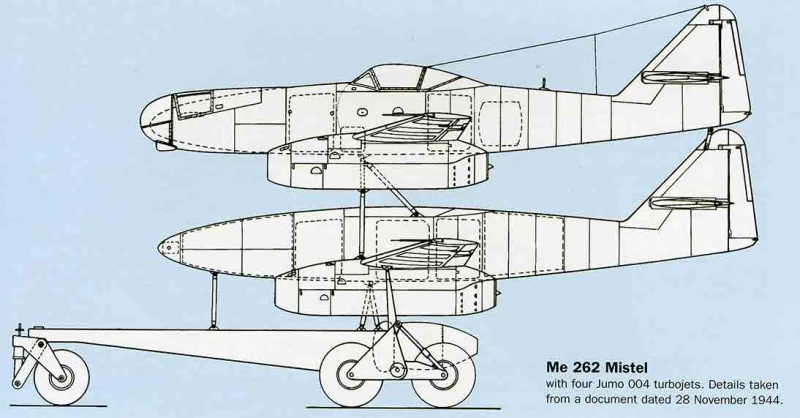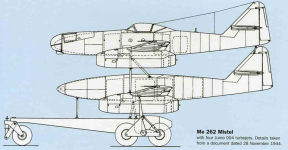Acetronics2
Grand Ayatollah
Pas forcément ...
il y a eu nombre de " bricolages " incontrôlés au cours de la fin de la seconde guerre, et la soumission au régime était devenue quasiment aussi " valorisante " que la créativité des inventeurs ...
on pouvait donc s'attendre à à peu près tout.
d'autre part, les Allemands balançaient un peu au hasard leurs V1 , voire V2 : il était donc nécessaire de trouver une solution guidée jusqu'au plus près de la cible. le concept du Mistel était d'ailleurs chose courante, mais effectivement, créer un biplan à partir d'un 262 était passablement osé ...
mais pas du tout inconcevable par les cerveaux dérangés de la fin de la guerre ...
Two Me 262s were delivered for conversion as Mistel during December 1944 but, as far as is known, the composite never flew before the end of the war. ...... There was also a proposal to use the Me 262with a Ju 88 lower component (possibly jet powered) and some authors have claimed (although this has yet to be confirmed by documentary evidence) that there was a project to combine the Me 262 with a Ju 287 as the explosive carrier"

Alain
il y a eu nombre de " bricolages " incontrôlés au cours de la fin de la seconde guerre, et la soumission au régime était devenue quasiment aussi " valorisante " que la créativité des inventeurs ...
on pouvait donc s'attendre à à peu près tout.
d'autre part, les Allemands balançaient un peu au hasard leurs V1 , voire V2 : il était donc nécessaire de trouver une solution guidée jusqu'au plus près de la cible. le concept du Mistel était d'ailleurs chose courante, mais effectivement, créer un biplan à partir d'un 262 était passablement osé ...
mais pas du tout inconcevable par les cerveaux dérangés de la fin de la guerre ...
From 'Me 262 Volume 2' by J Richard Smith and Eddie J Creek:
"By 1944, the problem with the conventionally powered Mistel was its vulnerability to enemy fighters before the lower component could be released on its target. Therefore, in November 1944, a proposal was put forward to use two Me 262s as the upper and lower components of a new Mistel 4. The upper component was to be a Me 262 A-2a/U2 with the Bomberkanzel (bomber nose) housing a second crew member who would help to aim the lower component at its target. It was estimated that this upper component would have a take-off weight of 6,985 kg (15,400 lbs) with a fuel load of 2,570 litres (680 Imp gallons).
The combination was mounted on a special five-wheeled trolley weighing 20 tons developed by Rheinmetal-Borsig. The lower Me 262 was mounted on the trolley, after which the mother aircraft would be lifted on top and connected to it by struts fitted with explosive bolts. Take-off was accomplished with the aid of four Walter 501 rocket units, the five-wheeled trolley being jettisoned shortly afterward in the manner of the early At 234 prototypes.
Three versions of the lower component were proposed, known as the Ausfuhrung A, B and C. Version A was to have an armoured fuselage nose with liquid explosive, Version B was to have the forward fuselage formed of solid explosive with similar material in other fuselage areas, and Version C was to have the forward fuselage of Version B but with liquid explosive in other areas. The first combination would have a total take-off weight of 16,900 kg (37,250 lbs), the second of 18,635 kg (41,080 lbs) and the third 17,100 kg (37,720 lbs).
Two Me 262s were delivered for conversion as Mistel during December 1944 but, as far as is known, the composite never flew before the end of the war. ...... There was also a proposal to use the Me 262with a Ju 88 lower component (possibly jet powered) and some authors have claimed (although this has yet to be confirmed by documentary evidence) that there was a project to combine the Me 262 with a Ju 287 as the explosive carrier"
Alain
Fichiers joints
Dernière édition:

